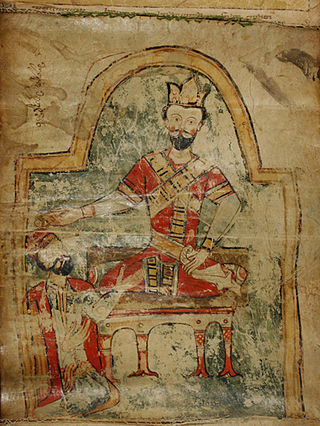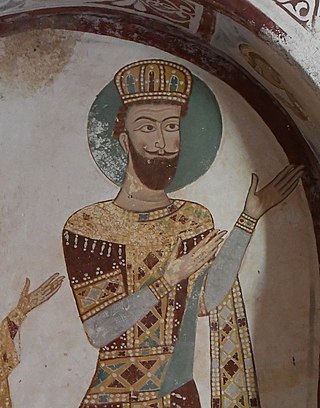Related Research Articles
David IV, also known as David IV the Builder, of the Bagrationi dynasty, was the 5th king (mepe) of the Kingdom of Georgia from 1089 until his death in 1125.

George I, of the Bagrationi dynasty, was the 2nd king (mepe) of the Kingdom of Georgia from 1014 until his death in 1027.

Bagrat III, also known as Bagrat the Unifier, of the Bagrationi dynasty, was the king (mepe) of the Kingdom of Abkhazia from 978 on and king of the Kingdom of Georgia from 1008 until his death in 1014. He united these two titles by dynastic inheritance and, through conquest and diplomacy, added more lands to his realm, effectively becoming the first king of the Kingdom of Georgia. Before Bagrat was crowned as king, he had also reigned in Kartli as co-ruler with his father Gurgen from 976 to 978.
Vakhtang V, born Bakhuta Mukhranbatoni, was king (mepe) of Kartli from 1658 until his death, who ruled as a vassal wali for the Persian shah. He is also known under the name of Shah Nawaz, which he assumed on being obliged outwardly to conform to Islam.

Vakhtang IV, of the Bagrationi dynasty, was a king (mepe) of Georgia who reigned from 1433 to his death, associated to the throne of his father Alexander I from 1433 to the latter's abdication in 1442 and sharing the throne with his three brothers until his death.

George VIII of the Bagrationi dynasty, was de facto last king (mepe) of the formerly united Kingdom of Georgia from 1446 to 1465. He would later rule in the Kingdom of Kakheti as George I from 1465 until his death in 1476, founding a local branch of the Bagrationi dynasty.

Alexander II was a king (mepe) of Georgia in 1478 and of Imereti from 1483 to 1510.
David X was the second king (mepe) of the Kingdom of Kartli from 1505 to 1525. Associated with the throne as a child, he became king on the death of his father and from then on had to endure invasions from the Kingdom of Imereti and Kingdom of Kakheti. A reformer, he succeeded in subduing the army and destroying the power of the nobles by abolishing the semi-independent principalities that were ruining the unity of the country, before uniting eastern Georgia under a single sceptre. David X is also known to have survived another invasion by Persia, and is thus considered to be the first in a series of eleven kings who fought against their Safavid neighbours over the next two centuries.

George XII, sometimes known as George XIII, of the House of Bagrationi, was the second and last king (mepe) of the Kingdom of Kartl-Kakheti in eastern Georgia from 1798 until his death in 1800.
David of Kakheti was a Choreposcopus of Kakheti, a principality of Eastern Georgia, who ruled from 976 until his death 1010.
Aghsartan I was a King of Kakheti and Hereti in eastern Georgia from 1058 until his death in 1084.
The Battle of Chikhori was fought between the armies of King George VIII of Georgia and the rebellious nobles led by a royal kinsman Bagrat in 1463. It took place near the fortress Chikhori in the district of Argveti in western Georgia, and ended in the king's decisive defeat.
Adarnase IV, or Adarnase II, was a Georgian monarch of the Bagrationi dynasty who reigned in the late 9th and early 10th centuries. The son of the Kouropalates David I of Iberia, he ruled as duke of Lower Tao from 881 to 923, king (mepe) of the Kingdom of the Iberians from 888 to 923 and Kouropalates of Iberia from 891 to 923, re-establishing the Georgian monarchy in 888, more than three centuries after the abolition of the Kingdom of Iberia by Sasanian Empire.

The Georgian–Seljuk wars, also known as Georgian Crusade, is a long series of battles and military clashes that took place from 1064 until 1213, between the Kingdom of Georgia and the different Seljukid states that occupied most of South Caucasus. The conflict is preceded by deadly raids in the Caucasus by the Turks in the 11th century, known in Georgian historiography as the Great Turkish Invasion.

The Kingdom of Kakheti-Hereti was an early medieval Georgian monarchy in eastern Georgia, centered at the province of Kakheti, with its capital first at Telavi. It emerged in c. 1014 AD, under the leadership of energetic ruler of principality of Kakheti, Kvirike III the Great that finally defeated the ruler of Hereti and crowned himself as a king of the unified realms of Kakheti and Hereti. From this time on, until 1104, the kingdom was an independent and separated state from the united Kingdom of Georgia. The kingdom included territories from riv. Ksani to Alijanchay river and from Didoeti to southwards along the river of Mtkvari.

The collapse of the Georgian realm was a political and territorial fragmentation process that resulted in the dynastic triumvirate military conflict of the Bagrationi monarchs and war of succession in the united Kingdom of Georgia culminating during the second half of the 15th century.
The Siege of Tbilisi (Georgian: თბილისის შემოერთება) in February 1122 was led by David IV, who successfully conquered the Emirate of Tbilisi, which had been established by the Arab conquests four centuries earlier. Having reclaimed Tbilisi, David's campaign marked the beginning of the end for Arab rule in Georgia; the Georgian army went on to retake the rest of the region and secured a critical victory in the Georgian–Seljuk wars. The collapse of the Emirate of Tbilisi also allowed the Kingdom of Georgia to contest territory within the rest of the weakening Seljuk Empire, laying a critical foundation for the Georgian Golden Age.
The Battle of Trialeti was fought between the armies of the Kingdom of Georgia and the Seljuk Empire in 1110. When the Georgians captured Samshvilde and Dzerna in 1110, the Seljuks felt this kind of defeat very hard and could not easily give up, so the Sultan of the Seljuk Empire sent 100,000 men to Georgia but they were defeated by 1,500 men under the command of David IV in Trialeti.
The siege of Samshvilde was a siege of the city of Samshvilde by the Bishop George of Chqondidi who captured the city on behalf of King David IV. This induced the Seljuks to hastily evacuate most of surrounding districts.

The Georgian conquest of Shirvan was a military conquest of Shirvan by David IV the Builder during the Georgian–Seljuk wars.
References
- ↑ Rapp 2000, p. 572.
- ↑ Toumanoff 1966, p. 624.
- ↑ Rayfield 2012, p. 80.
- ↑ Asatiani & Bendianashvili 1997, p. 118.
- ↑ Allen 1932, p. 98.
- ↑ Toumanoff 1976, p. 552.
- ↑ Brosset 1849, p. 354.
- ↑ Asatiani & Janelidze 2009, p. 81.
- ↑ QAUXČʻIŠVILI, S., VIVIAN, K., & BRYER, A. (1991). The Georgian chronicle: the period of Giorgi Lasha. Amsterdam, A.M. Hakkert.
- ↑ Javakhishvili 1949, pp. 44–45.
- 1 2 Rayfield 2012, p. 86.
- ↑ Salia 1980, p. 176.
- ↑ Kaukhchishvili 1955, p. 328.
- ↑ Brosset 1849, pp. 356–357.
- ↑ History of Georgia 2012, p. 341.
- ↑ Kartlis Tshovreba, p. 346.
